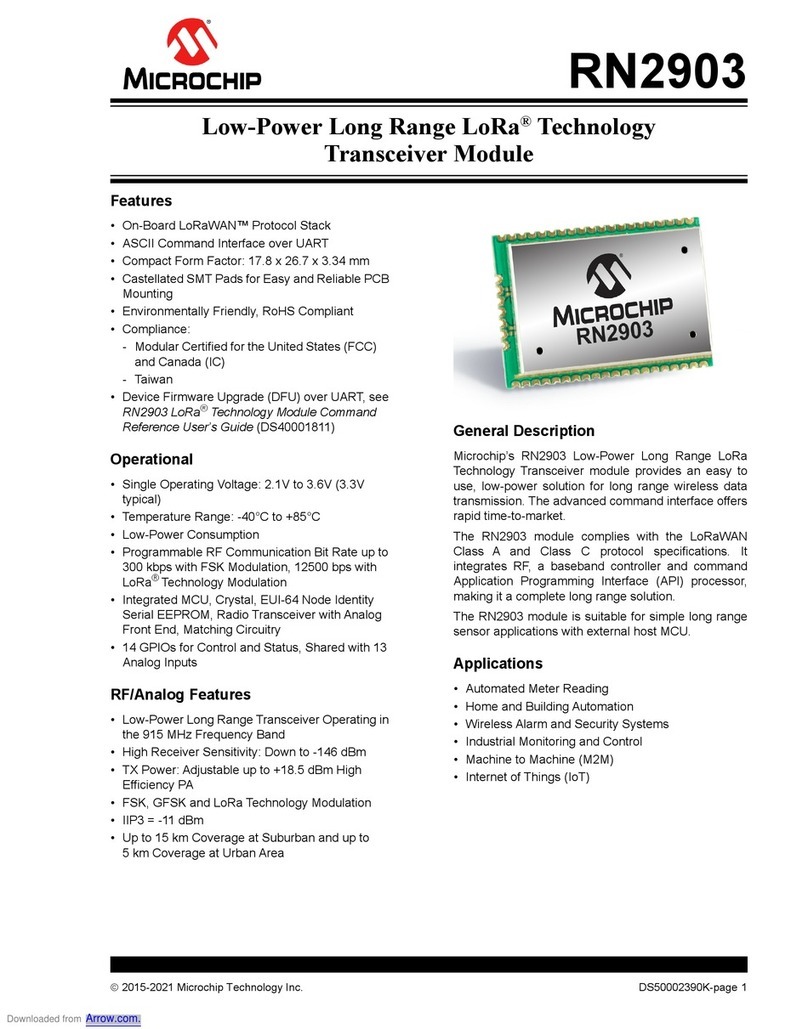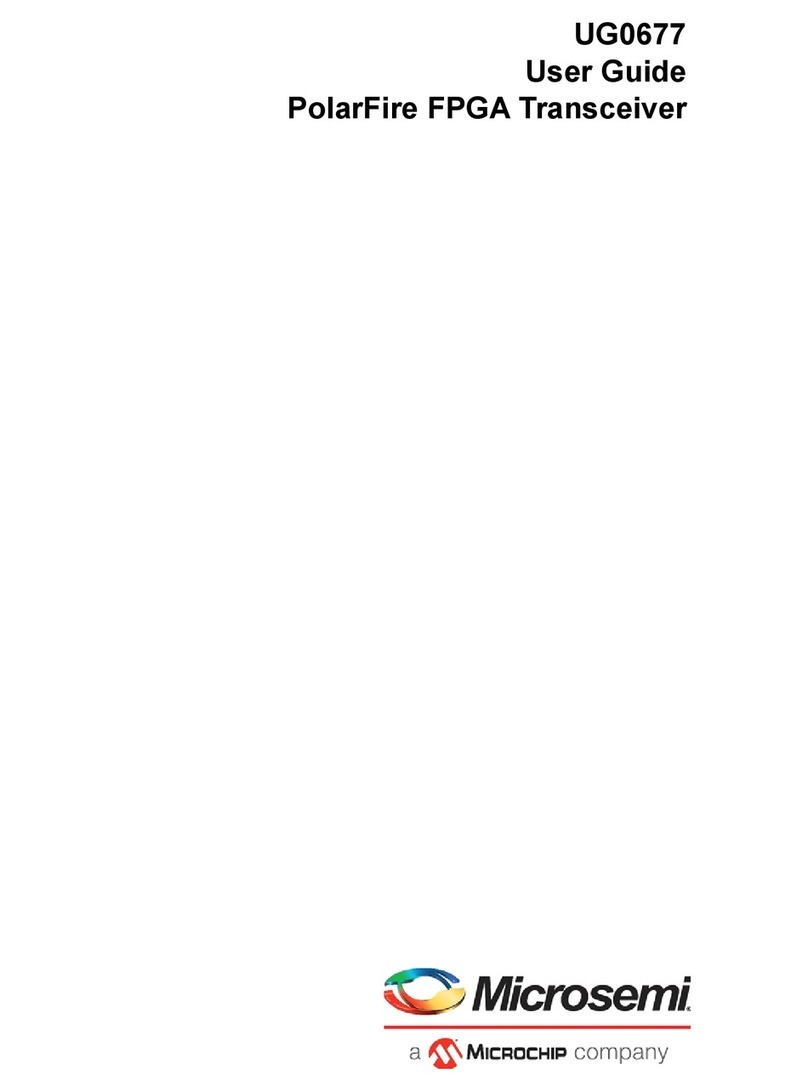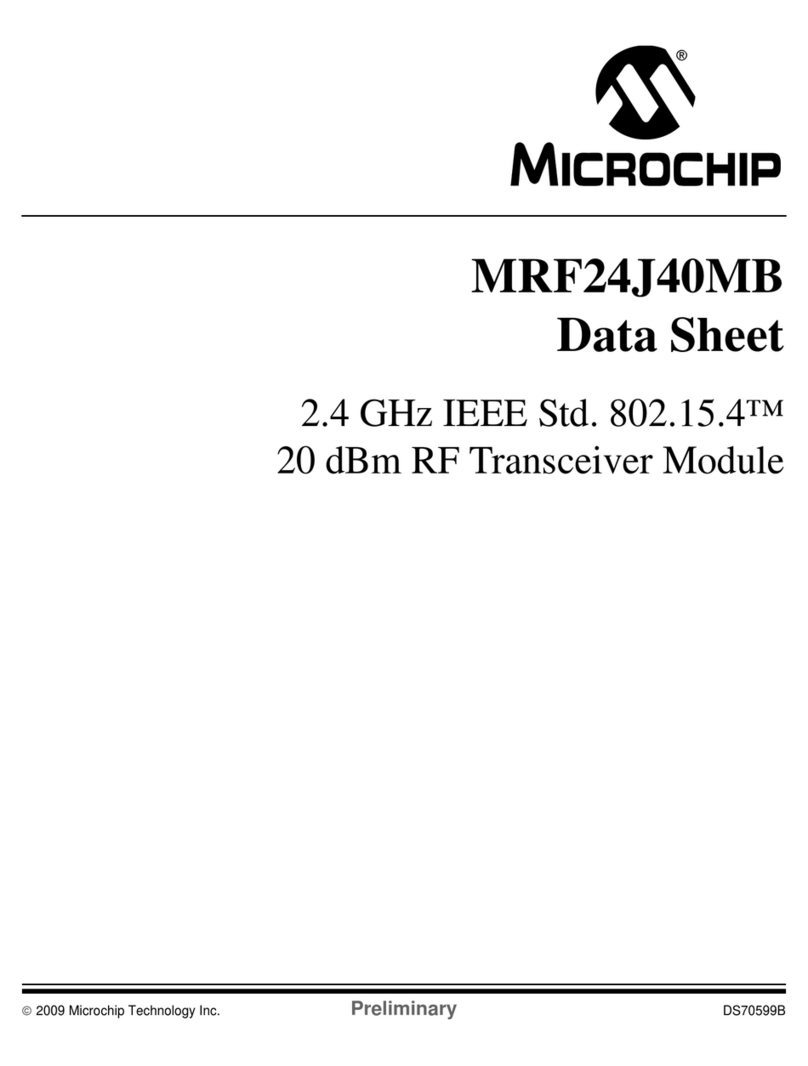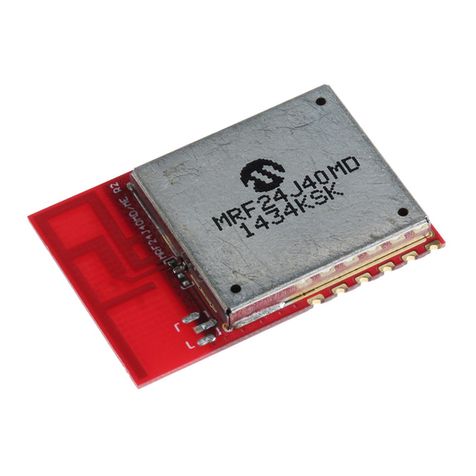
Microsemi Proprietary and Confidential UG0936 User Guide Revision 1.0 v
Figures
Figure 1 Transceiver Lane Overview . . . . . . . . . . . . . . . . . . . . . . . . . . . . . . . . . . . . . . . . . . . . . . . . . . . . . . . 3
Figure 2 Transceiver Receiver . . . . . . . . . . . . . . . . . . . . . . . . . . . . . . . . . . . . . . . . . . . . . . . . . . . . . . . . . . . . 6
Figure 3 Receiver Input Buffer . . . . . . . . . . . . . . . . . . . . . . . . . . . . . . . . . . . . . . . . . . . . . . . . . . . . . . . . . . . . 6
Figure 4 Input Signal Path . . . . . . . . . . . . . . . . . . . . . . . . . . . . . . . . . . . . . . . . . . . . . . . . . . . . . . . . . . . . . . . 7
Figure 5 CDR Lock Mode Options . . . . . . . . . . . . . . . . . . . . . . . . . . . . . . . . . . . . . . . . . . . . . . . . . . . . . . . . . 9
Figure 6 Transceiver Transmitter . . . . . . . . . . . . . . . . . . . . . . . . . . . . . . . . . . . . . . . . . . . . . . . . . . . . . . . . . 12
Figure 7 Transmit Output Driver . . . . . . . . . . . . . . . . . . . . . . . . . . . . . . . . . . . . . . . . . . . . . . . . . . . . . . . . . . 13
Figure 8 Enhanced Receiver Management in XCVR Configurator . . . . . . . . . . . . . . . . . . . . . . . . . . . . . . . . 15
Figure 9 Calibration Options for Enhanced Receiver Management Operations . . . . . . . . . . . . . . . . . . . . . . 15
Figure 10 Exposing RX_READY_CDR and RX_VAL_CDR Pins . . . . . . . . . . . . . . . . . . . . . . . . . . . . . . . . . . 16
Figure 11 DFE Options . . . . . . . . . . . . . . . . . . . . . . . . . . . . . . . . . . . . . . . . . . . . . . . . . . . . . . . . . . . . . . . . . . 17
Figure 12 First Lock Calibration Waveform . . . . . . . . . . . . . . . . . . . . . . . . . . . . . . . . . . . . . . . . . . . . . . . . . . . 17
Figure 13 Disruption of Serial Rx Data Stream . . . . . . . . . . . . . . . . . . . . . . . . . . . . . . . . . . . . . . . . . . . . . . . . 18
Figure 14 Restart after Initialization . . . . . . . . . . . . . . . . . . . . . . . . . . . . . . . . . . . . . . . . . . . . . . . . . . . . . . . . 18
Figure 15 On-Demand Calibration Waveform . . . . . . . . . . . . . . . . . . . . . . . . . . . . . . . . . . . . . . . . . . . . . . . . . 19
Figure 16 8b10b Data Path . . . . . . . . . . . . . . . . . . . . . . . . . . . . . . . . . . . . . . . . . . . . . . . . . . . . . . . . . . . . . . . 22
Figure 17 64b6xb Data Path . . . . . . . . . . . . . . . . . . . . . . . . . . . . . . . . . . . . . . . . . . . . . . . . . . . . . . . . . . . . . . 28
Figure 18 64b66b Receive Sequence For 32-Bit Interface . . . . . . . . . . . . . . . . . . . . . . . . . . . . . . . . . . . . . . . 30
Figure 19 64b66b Receive Sequence For 64-Bit Interface . . . . . . . . . . . . . . . . . . . . . . . . . . . . . . . . . . . . . . . 30
Figure 20 64b66b Transmit Sequence For 64-Bit Interface . . . . . . . . . . . . . . . . . . . . . . . . . . . . . . . . . . . . . . 31
Figure 21 64b66b Transmit Sequence For 32-Bit Interface . . . . . . . . . . . . . . . . . . . . . . . . . . . . . . . . . . . . . . 31
Figure 22 64b67b Transmit Sequence For 32-Bit Interface . . . . . . . . . . . . . . . . . . . . . . . . . . . . . . . . . . . . . . 32
Figure 23 64b67b Receive Sequence For 32-Bit Interface . . . . . . . . . . . . . . . . . . . . . . . . . . . . . . . . . . . . . . . 33
Figure 24 Initial Receiver Detection Response For Receiver-Not-Present . . . . . . . . . . . . . . . . . . . . . . . . . . . 40
Figure 25 Initial Receiver Detection For Receiver-Present . . . . . . . . . . . . . . . . . . . . . . . . . . . . . . . . . . . . . . . 41
Figure 26 Subsequent Receiver Detection Where Prior Status Was Receiver-Not-Present . . . . . . . . . . . . . 41
Figure 27 PMA-Bus Waveform . . . . . . . . . . . . . . . . . . . . . . . . . . . . . . . . . . . . . . . . . . . . . . . . . . . . . . . . . . . . 42
Figure 28 PMA Only Data Path – 80-bits . . . . . . . . . . . . . . . . . . . . . . . . . . . . . . . . . . . . . . . . . . . . . . . . . . . . 42
Figure 29 PMA Only Data Path – Less Than or Equal to 40-bits . . . . . . . . . . . . . . . . . . . . . . . . . . . . . . . . . . 43
Figure 30 Global-shared Clocking Example . . . . . . . . . . . . . . . . . . . . . . . . . . . . . . . . . . . . . . . . . . . . . . . . . . 46
Figure 31 Non-Deterministic Interface With FWF . . . . . . . . . . . . . . . . . . . . . . . . . . . . . . . . . . . . . . . . . . . . . . 47
Figure 32 Non-Deterministic Interface Transmit Timing Waveform . . . . . . . . . . . . . . . . . . . . . . . . . . . . . . . . 47
Figure 33 Non-Deterministic Transceiver Receive Timing Waveform . . . . . . . . . . . . . . . . . . . . . . . . . . . . . . 47
Figure 34 Deterministic Timing Interface . . . . . . . . . . . . . . . . . . . . . . . . . . . . . . . . . . . . . . . . . . . . . . . . . . . . 48
Figure 35 Deterministic Transceiver Transmit Timing Waveform . . . . . . . . . . . . . . . . . . . . . . . . . . . . . . . . . . 48
Figure 36 Deterministic Transceiver Receive Timing Waveform . . . . . . . . . . . . . . . . . . . . . . . . . . . . . . . . . . 49
Figure 37 Transceiver Clock Regions . . . . . . . . . . . . . . . . . . . . . . . . . . . . . . . . . . . . . . . . . . . . . . . . . . . . . . . 49
Figure 38 Transmit PLL . . . . . . . . . . . . . . . . . . . . . . . . . . . . . . . . . . . . . . . . . . . . . . . . . . . . . . . . . . . . . . . . . 52
Figure 39 Spread Spectrum Clocking Modulation Mode . . . . . . . . . . . . . . . . . . . . . . . . . . . . . . . . . . . . . . . . 54
Figure 40 Using TXPLL_SSC For Upto Four Lanes . . . . . . . . . . . . . . . . . . . . . . . . . . . . . . . . . . . . . . . . . . . . 55
Figure 41 Using TXPLLs For Upto Four Lanes . . . . . . . . . . . . . . . . . . . . . . . . . . . . . . . . . . . . . . . . . . . . . . . . 56
Figure 42 FPGA Logic For TX Alignment (5 to 8 Lanes) . . . . . . . . . . . . . . . . . . . . . . . . . . . . . . . . . . . . . . . . 57
Figure 43 Reference Clock (REFCLK) Interface to Transmit PLL . . . . . . . . . . . . . . . . . . . . . . . . . . . . . . . . . 59
Figure 44 Typical Jitter Attenuator Application Scheme . . . . . . . . . . . . . . . . . . . . . . . . . . . . . . . . . . . . . . . . . 60
Figure 45 Jitter Attenuation TXPLL . . . . . . . . . . . . . . . . . . . . . . . . . . . . . . . . . . . . . . . . . . . . . . . . . . . . . . . . . 61
Figure 46 JAPLL Custom Protocol Setting . . . . . . . . . . . . . . . . . . . . . . . . . . . . . . . . . . . . . . . . . . . . . . . . . . . 62
Figure 47 Reference Clock Source Options . . . . . . . . . . . . . . . . . . . . . . . . . . . . . . . . . . . . . . . . . . . . . . . . . . 62
Figure 48 Rx JA Clock Frequency (XCVR Configurator) . . . . . . . . . . . . . . . . . . . . . . . . . . . . . . . . . . . . . . . . 62
Figure 49 Dedicated Transceiver Reference Clock Inputs . . . . . . . . . . . . . . . . . . . . . . . . . . . . . . . . . . . . . . . 63
Figure 50 REFCLK Input Pin Diagram . . . . . . . . . . . . . . . . . . . . . . . . . . . . . . . . . . . . . . . . . . . . . . . . . . . . . . 65
Figure 51 RTPF500T Transceiver and Transmit PLL Layout . . . . . . . . . . . . . . . . . . . . . . . . . . . . . . . . . . . . . 67
Figure 52 PCS Rate Switch between 8b10b and 64b66b Mode . . . . . . . . . . . . . . . . . . . . . . . . . . . . . . . . . . . 69
Figure 53 Transceiver Reference Clock Selection from Catalog . . . . . . . . . . . . . . . . . . . . . . . . . . . . . . . . . . 76
Figure 54 Transceiver Reference Clock Configurator GUI . . . . . . . . . . . . . . . . . . . . . . . . . . . . . . . . . . . . . . . 77































